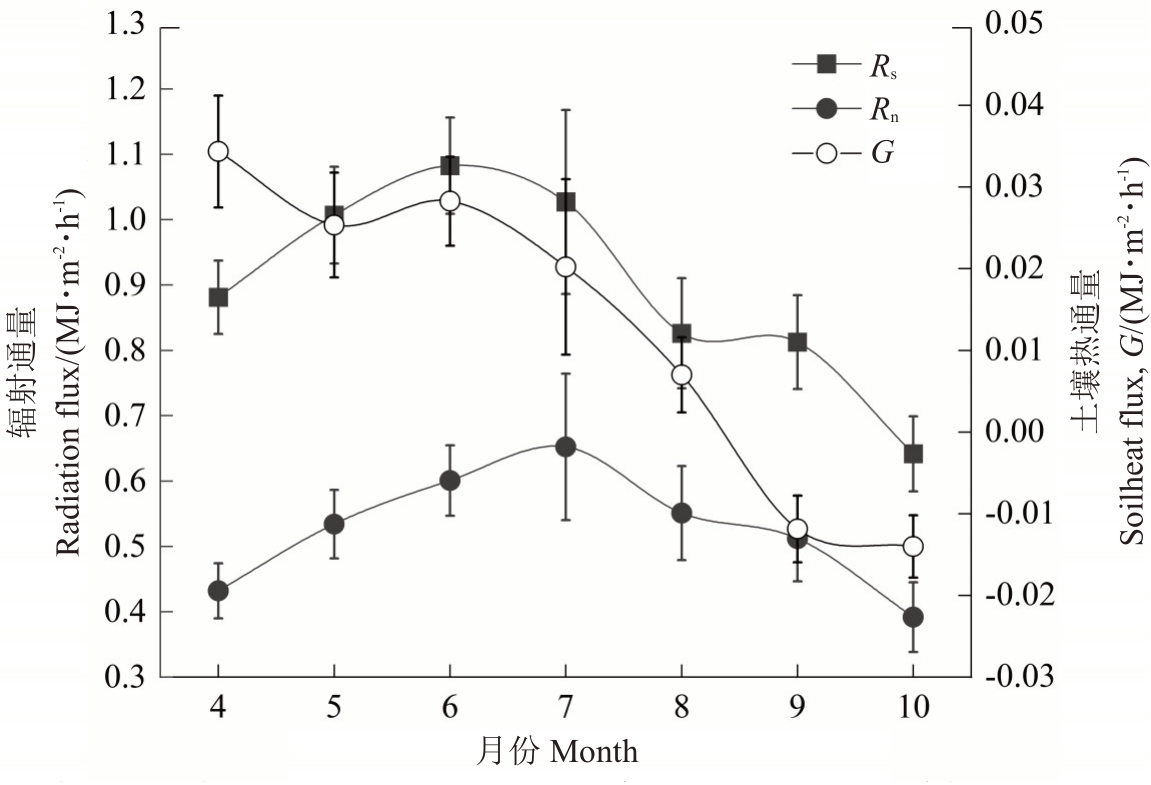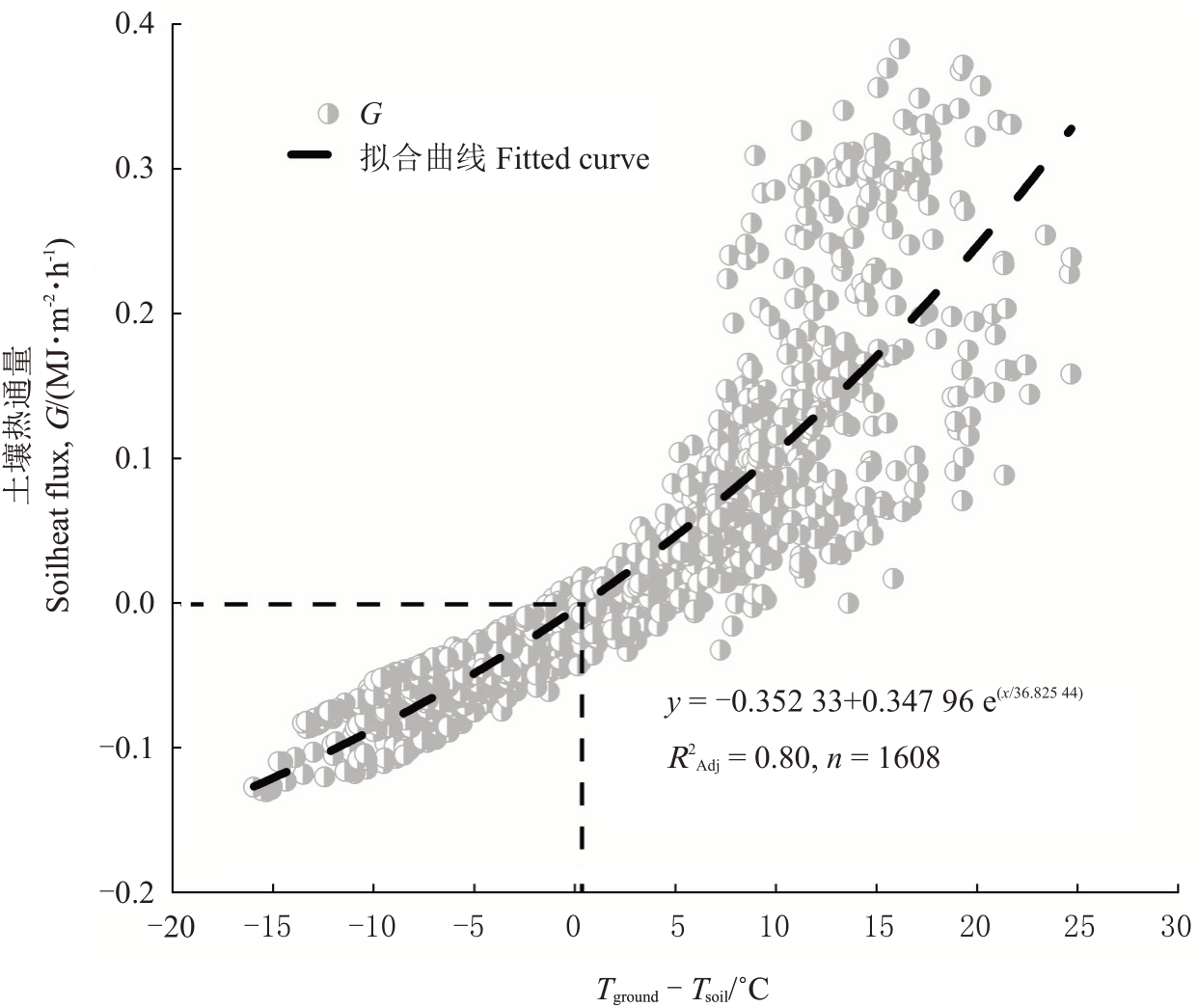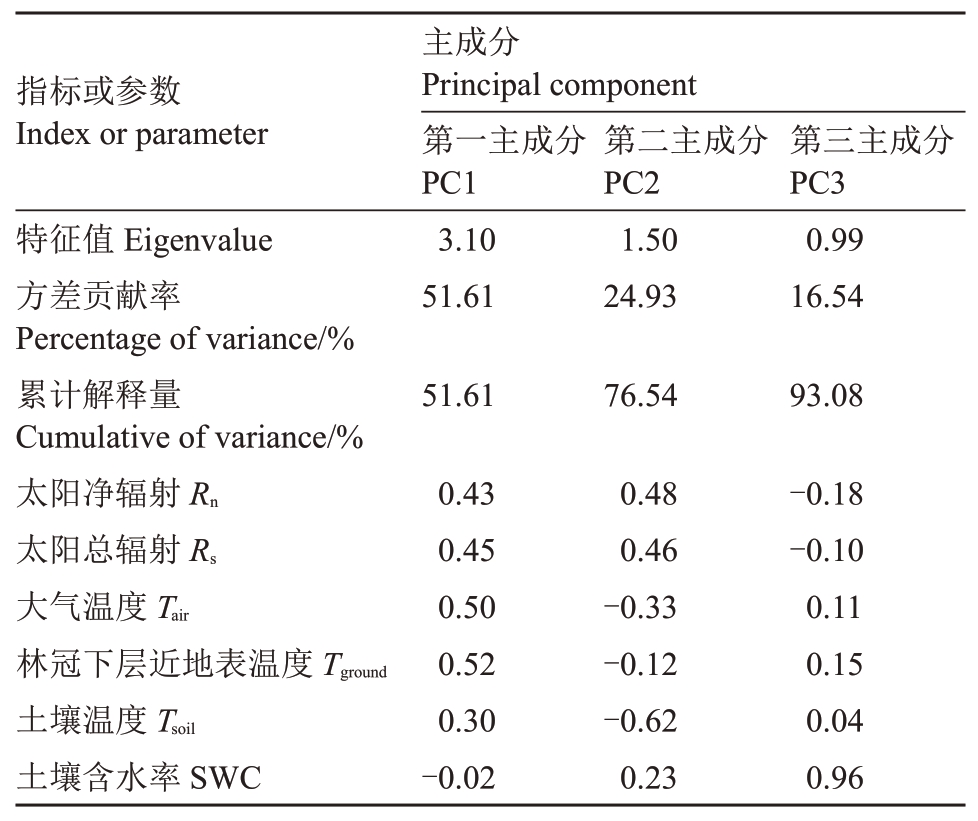热量是果树生长发育必要的资源条件,直接影响果树产量与果品品质[1]。在反映热量的众多指标中,大气温度与果树芽的萌动有密切的关联,积温与果实的生长发育进程、品质与产量关联紧密。大气温度过高或过低都不利于果树的生长发育,其中高温不仅会直接造成灼伤,而且还会引起果树叶片气孔不闭合,加剧树体水分过度散失,影响幼果发育或直接造成落叶落果[2];低温将导致冻害,直接使花或幼果器官受损,或降低花粉活力从而使果树严重减产[3-5]。土壤温度的高低及其变化对土壤呼吸、根系生长和养分的吸收等过程有直接的影响[6-7],适宜的土壤温度能够促进土壤的碳、氮循环和根-土间物质的运输[8]。土壤温度的高低及其变化受土壤热通量变化过程的直接影响[9]。太阳辐射作为热源,直接影响着大气温度的变化,但由于受果园冠层的影响,果园系统内的热量微循环过程与太阳辐射过程并不一致,从而导致果园内的水分循环过程变得比较复杂[10-11]。
黄土高原光照充足,昼夜温差大,土层深厚,气象与土壤条件非常适宜苹果种植,是全国唯一符合苹果生长要求7 项气候指标的优生区,被誉为世界公认的最大苹果优生区[12]。目前,尽管苹果矮砧栽培模式是黄土高原有灌溉条件园地的发展方向,但现有的果园绝大部分是乔砧园,果园郁闭度大,冠层内的光照、水热循环过程变化异常。前人的研究多数为果树修剪、病虫害防治、肥和水调控等方面[10,13-16],对果园小气候特征研究尽管有涉及[13,17],但缺少对果园系统内、外热量特征变化的对比研究,从而对冠下的水、热循环过程缺乏较完整的认识。基于此,笔者通过对苹果树冠层外大气、近地表层大气和土壤3 个空间维度上温度等变量的监测,分析了热量的空间差异特征及在不同生育期的变化,为黄土区苹果园高光效群体和个体结构调整、适时病虫害防治和水肥施用等技术措施的制定提供理论依据。
1 材料和方法
1.1 试验地概况
试验地设于山西省临汾市吉县东城乡雷家庄村有机苹果种植园(110°35.655′ E,36°04.739′ N),海拔910 m,属于黄土残塬沟壑区。该地区属暖温带大陆性季风气候,春季干旱多风,夏季降雨集中,年均气温10.2 ℃,年均日较差11.5 ℃,年均降水522.8 mm,≥10 ℃的有效积温3 361.5 ℃,多年平均日照时数2538 h。观测研究期(2018 年)共计降雨374.8 mm。土壤机械组成以黏粒和粉粒为主,分别占42.6%和41.6%,1 m内土层平均土壤容重为1.34 g·cm-3,土壤有机质质量分数平均为0.85%[18]。所选样地为2000 年建植,面积1.7 hm2,品种为‘红富士’,砧木为海棠,树形为自由纺锤形,栽植密度4 m×6 m,树冠平均高为2.5 m。果园架设防雹网,技术管理较好,平均年产果量约4 t·hm-2。
1.2 仪器安装与数据观测
于2018 年3 月份在果园中心区架设竖杆,将CMP11 太阳总辐射传感器、NR-LITE2 太阳净辐射传感器(Kipp&Zonen,荷兰)和AV-10TH 空气温湿度传感器(AVALON,美国)安装于离地面高约3 m处的水平支架上,分别监测冠层外太阳总辐射(Rs)、净辐射(Rn)和大气温度(Tair)。同时,以竖杆为中心的等边三角形(边长10 m)的顶点位置选择3个点立一木桩,每个木桩在近地表20 cm处的高度安装AV-10TH空气温湿度传感器各1套,监测林冠内近地表大气温度(Tground)。在竖杆位置深约10 cm的土层处埋设HFP01 土壤热通量传感器(Huk Sefflux,荷兰)记录土壤热通量(G)动态。以上传感器均与SQ2020 数据采集器(Grant,英国)相连接以收集数据。另外,在三角形顶点位置深10 cm 土层处各埋设ECH2O 土壤水分传感器(Decagon,美国)并与Em50 数据采集器(Decagon,美国)相连接,用于监测土壤含水率(Soil Water Content, SWC)和土壤温度(Tsoil)。两台数据采集器记录、采集时间间隔均分别设定为10、30 min。
1.3 数据分析
参照前期研究结果对试验园苹果树进行各生育期的季节划分[19]。本试验只选取主要生育期(4—10月)的4个时期,即:花期(4月份)、幼果期(5月份)、果实膨大期(6—8月份)和果实成熟期(9—10月份)为研究时段。
选取苹果主要生育期典型晴天(日间天空无云,太阳辐射日变化过程基本呈正态型曲线,共计67 d)的数据开展分析。基于收集的原始数据计算出Tair、Tground、Tsoil、Rs、Rn和G 等变量的每小时、每日、每月的平均值,并统计以上变量在各生育期的平均值。采用统计软件Origin 2020 进行单因素方差分析(oneway ANOVA) 、主成分分析(Principal Component Analysis)并绘图。
2 结果与分析
2.1 Tair、Tground、Tsoil的季节变化特征
试验果园冠层外大气温度(Tair)、近地表大气温度(Tground)和表层土壤温度(Tsoil)的季节动态总体上呈先升后降的季节变化趋势(图1-A)。Tair、Tground、Tsoi 3 类温度的值在4 月份平均分别为15.2、17.5、14.3 ℃,7 月份上升到最高值,分别为26.3、26.8、25.8 ℃。10 月份分别下降至10.7、11.1、13.0 ℃。4—8 月份期间Tground均高于Tair和Tsoil,而在8 月份之后,Tground快速下降,使得Tsoil均高于Tground、Tair。整个观测期内,Tair、Tground、Tsoil 的最高值分别为35.1、37.5、27.3 ℃,分别在6 月、6 月与7 月出现,最低值分别为-5.4、-6.7、8.1 ℃,分别在4 月、4 月与10 月出现。试验期间Tground >35 ℃的高温时长达59 h,其中4 月份(花期)Tground >35 ℃的高温时长达14 h,Tground >30 ℃的时长达77 h;而低温Tground <0 ℃的时长达51 h,其中4 月份有18 h;Tair <0 ℃的时长共31 h,其中4月份有12 h。

图1 果园冠层外大气温度(Tair)、近地表空气温度(Tground)和表层土壤温度(Tsoil)的季节动态
Fig.1 Seasonal dynamics of air temperature above the canopy(Tair),ground air temperature(Tground)and upper soil temperature(Tsoil)in apple orchard
A.Tair、Tground、Tsoil月平均值的季节动态;B.Tair、Tground、Tsoil日温差的季节动态。
A.Seasonal dynamics of daily means of Tair,Tground and Tsoil;B.Seasonal dynamics of daily temperature differences of Tair,Tground and Tsoil.
对一日内温差的统计表明,Tair、Tground在4月份的日温差分别达18.3、28.0 ℃,之后一直呈降低的季节变化趋势,到8 月份时达到最低,分别为13.2 ℃和14.4 ℃。之后又呈升高的季节变化趋势。Tsoil的日温差则表现为整体递减的季节变化趋势,4 月份最高(3.8 ℃),10月份降至最低(2.1 ℃)(图1-B)。
2.2 Rs、Rn和G的季节变化特征
太阳辐射(Rs)、净辐射(Rn)和土壤热通量(G)是表述果园热量传输特征的重要变量。结果表明,Rs、Rn的季节变化均呈现先增后减的趋势,而G 则整体上为下降趋势(图2)。4月份,Rs、Rn的平均值分别为0.88、0.43 MJ·m-2·h-1;6 月份,Rs 升至最高值1.08 MJ·m-2·h-1,而Rn 则在7 月份达到最大值0.65 MJ·m-2·h-1;10月份,Rs、Rn均降至最低,分别为0.64、0.39 MJ·m-2·h-1。G在4月份最大,为0.034 MJ·m-2·h-1,9、10月出现负值,分别为-0.012、-0.014 MJ·m-2·h-1,生长季初期与末期差值为0.044 MJ·m-2·h-1。整个观测期内Rs、Rn、G 的最高值分别为3.74、2.80、0.38 MJ·m-2·h-1,出现日期分别在2018年的6月9日、8月23日和4月7日。

图2 典型晴天果园中太阳总辐射(Rs)、太阳净辐射(Rn)和土壤热通量(G)的季节变化
Fig.2 Seasonal variations of total solar radiation(Rs),net solar radiation(Rn)and soil heat flux(G)in typical sunny days in apple orchard
2.3 主要生育期Tair、Tground、Tsoil日变化特征
对果园在各生育期典型晴天3类温度的日变化过程分析表明,总体而言,在夜间,Tsoil普遍高于Tair和Tground,而在白天,Tground普遍高于Tair。日温差则总体上表现为Tground >Tair >Tsoil的规律。从花期、幼果期、果实膨大期到果实成熟期,上述3 类温度趋于一致的时段上午分别为8:00—9:00、8:00—9:00、7:00—9:00、9:00—11:00,下午则分别为20:00—21:00、20:00—21:00、20:00—21:00、18:00—19:00。各生育期Tair、Tground、Tsoil3类温度每日最高值出现的时间明显不同,Tair 在14:00—15:00、Tground 在12:00—15:00,而Tsoil明显滞后,在20:00—21:00(图3)。Tsoil在达到峰值后整个夜间持续下降,最低值一直延续到翌日10:00时左右。

图3 不同生育期典型晴天果园冠层外大气温度(Tair)、近地表空气温度(Tground)和表层土壤温度(Tsoil)的日变化过程
Fig.3 Diurnal processes of air temperature above canopy(Tair),ground air temperature(Tground)and upper soil temperature(Tsoil)in typical sunny days in apple orchard at different growing stages
2.4 主要生育期Rs、Rn、G的日变化特征
对果园在各生育期典型晴天Rs、Rn、G日变化过程分析表明,3 类热量变量均呈典型的正态型日分布格局,Rn日变化趋势与Rs日变化具有明显的一致性,而G的日变化则迟于Rn(图4)。在主要生育期,Rs、Rn的日峰值均出现在12:00,而G 的日峰值则出现在14:00或13:00。Rn的日峰值在花期、幼果期、果实膨大期、果实成熟期4 个生育期中分别为2.037、2.012、2.189、2.140 MJ·m-2·h-1,分别占同期Rs 的69.2%、62.9%、69.7%、81.1%,而同期的G 值分别只占Rn的15.8%、13.9%、9.5%、5.5%。一日内G >0 的时段从花期到果实膨大期均在9:00—19:00,而果实成熟期在11:00—18:00,较其他生育期缩短3 h(图4)。

图4 不同生育期典型晴天果园太阳总辐射(Rs)、太阳净辐射(Rn)和土壤热通量(G)的日变化过程
Fig.4 Diurnal processes of total solar radiation(Rs),net solar radiation(Rn)and soil heat flux(G)in typical sunny days in apple orchard at different growing stages
2.5 近地表空气与表层土壤间的温差(Tground-Tsoil)及与土壤热通量(G)的关系
统计分析显示:近地表与表层土壤间的温差(Tground-Tsoil)在整个试验期间变化为-16.0~24.7 ℃,平均为1.0 ℃,中位数值为-1.17 ℃。Tground-Tsoil与G 间表现为指数函数关系(R2Adj=0.80,n=1608)。进一步分析表明,当Tground-Tsoil <0.5 ℃时,G为负,即土壤层作为热源向近地表空气层释放热量,并且在此区间G 与Tground-Tsoil间的关系紧密;而随着Tground-Tsoil 增大,G 由负值转变为正,土壤层作为热汇吸收近地表空气层的热量。特别地,当Tground-Tsoil高于约5 ℃后,G随Tground-Tsoil的增加而快速增加(图5)。

图5 冠下近地表空气温度和土壤间温差(Tground-Tsoil)与土壤热通量(G)间的关系
Fig.5 Relationships between the difference of ground air temperature to upper soil temperature(Tground-Tsoil)and soil heat flux(G)
2.6 影响土壤热通量的因子主成分分析
Pearson 相关分析结果表明:G 与热量因子Rs、Rn、温度因子Tair、Tground及土壤水分因子SWC 间均存在极显著(p <0.01)的正相关关系,其中与Tground相关性最紧密(R2=0.72)。为进一步确定影响G各因子间的贡献,对典型晴天下日间的Rs、Rn、Tair、Tground、Tsoil和SWC 等6 个变量采用PCA 主成分分析方法进行降维分析,结果表明,前3个主成分的累积方差贡献率为93.08%(表1)。第一主成分对环境因子数据信息量的方差贡献率为51.61%,Tair、Tground在该主成分上的载荷较高,归为温度类;第二主成分的方差贡献率为24.93%,Rs、Rn等变量在该主成分上的载荷较高,归为辐射类;第三主成分的方差贡献率为16.54%,土壤含水率在该主成分上的载荷高达0.96,归为土壤水分类。
表1 基于PCA 分析的环境因子特征值和方差贡献率及各初始因子在不同主成分上的载荷
Table 1 Eigenvalues and percentage of variance of environmental factors and load of each initial factor on different principal components based on PCA analysis

?
3 讨 论
3.1 果园外-果园内-土壤间的温度梯度
果园小气候不仅直接影响果树的光合、呼吸及生长发育,而且对果园土壤有机质分解、养分的迁移转化、水热交换等均产生重要影响[13,20]。本次研究表明,从生长季初的4 月份一直到气温最高的7 月份,果园内近地面气温均高于冠层外气温,在果园冠层叶幕尚未完全发育形成的早期,果园内湍流交换强,太阳辐射能较多地进入到果园,白天太阳辐射增强,地面温度很快升高,地面形成对近表层对流层大气的主要热源[21]。同时冠层叶片的蒸腾降温效应也促进了冠层外气温的下降[22]。8月份之后,由于冠层郁闭的加大及太阳辐射的减弱,Tground与Tair值基本相近。4月份,Tground的日温差高达28.9 ℃,4—8月份呈下降趋势,8月份后转为上升趋势,到10月份时达到21.8 ℃。生长季初、末近地面空气温度较大的日温差是晚霜、早霜危害加重的主要气象原因[23],生产实践中应及早采取措施预防。
土壤温度通过影响果树根系生长发育从而对果树的水肥循环过程有着重要的影响。土壤温度受大气温度、土壤热传导特性、地表覆盖等多种因素的影响[13]。本次研究发现,4 月份的Tsoil比Tground平均低3.2 ℃。之后,Tsoil上升的速度较Tground快,到8月份二者基本相同,并在之后Tsoil明显高于Tground,土壤成为下垫面气流的热源。这提示在生长季早期应通过疏松土壤等措施及时提高地温,促进水肥的循环,而在生长季末增加疏透度,以及时降低土壤温度,抑制营养生长,促进果实发育。在整个生长季中,Tsoil的日温差均较小(低于3.8 ℃),并呈逐渐降低的季节变化趋势,这有利于苹果根系生长,而且对于土壤微生物活性、物质能量的转化具有重要促进作用[13]。
气象学将日最高气温高于35 ℃定义为高温日,这一温度也是北方多种果树的适宜生长温度上限。研究表明,当高温日持续2 d后就会对果树造成明显的高温热害(日灼),给果实品质带来严重影响[20]。本次试验期间观测的Tground的最高值为37.5 ℃,高于35 ℃的小时数达58 h,这表明除了干旱外,高温日灼灾害可能是黄土区旱作果园面临的另一考验,需要加以防范。特别地,开花期的苹果树适宜温度上限仅为25 ℃,当日最高气温达到30 ℃时可能造成严重落花[20]。在本次观测中,开花期Tground高于30 ℃的小时数为77 h,这对果树的生长严重不利。
3.2 果园内土壤热通量的变化
土壤热通量是地表能量平衡的重要分量[24]。研究发现,苹果园在果树生长季初期(4 月)的土壤热通量最高,之后表现出逐渐下降的季节变化动态,这与同步观测的太阳辐射先增后降的季节变化趋势并不一致。这一现象反映了果园的生育规律,尤其是冠层叶面积指数(LAI)的季节变化规律。对该果园LAI 的动态监测结果表明,LAI 自4 月1 日起的45 d内从接近0 快速增至3.2 以上,此后的6—10 月份一直维持在3.4 这一水平,直至11 月份低温大风天气后快速降至0[19]。这说明果园在大部分时间因郁闭的冠层而影响辐射向地面输入。随着果园树冠的郁闭,更大比例的太阳辐射能量主要用于系统蒸发散热的潜热通量[25]。7 月、8 月果园降水总量分别为121.2和66.6 mm,且1 m内土壤平均含水率(w)分别为14.4%和14.6%,均为一年中次高和最高。雨季土壤所获得的热量有相当一部分用于了潜热变化[9]。9月、10月,G转变为负值,土壤作为热源,向大气传递热量。本研究还发现,在日尺度上,G峰值出现的时刻较Rn约晚2 h,其对Rn的反馈存在滞后性,这与前人报道的滞后时长在2~6 h 基本一致[26-29]。土壤热通量的变化通常以净辐射为基础,受冠层的遮挡以及林内微环境的影响,由太阳辐射转变为土壤热量,并且热量差异产生热通量需要一定时间[27,30]。分析表明,影响旱作果园G 的因子主要为温度类因子,其中与Tground的相关性最密切。G 值的正负间转变反映了土壤作为热汇吸收或作为热源释放能量的动态过程,其日、季变化反映了果园土壤层能量收支状况,对认识果园小气候特征有重要价值[9]。
4 结 论
果园种植系统显著改变了地-气间热量循环与分配过程。近地表大气温度比冠层外大气温度高0.4~2.3 ℃,花期(4月份)既有近地面气温高于30 ℃的高温日(时长77 h),也有低于0 ℃的低温日(时长18 h),会分别造成灼害和冻害。近地表气温的日温差最高可达28 ℃(花期),比冠层外大气温度的日温差高9.7 ℃,增大了冻害的风险与程度。整个生长季期间,土壤热通量呈递减的趋势,与太阳辐射先增后降的季节变化趋势并不一致,体现了果园种植系统冠层发育过程对热量循环与分配过程的改变。土壤热通量在果实成熟期(9—10 月份)降为负值,此时近地表气温低于土壤温度,土壤层作为热源向近地表空气层释放热量。太阳辐射驱动土壤热通量的变化,但温度类变量比辐射类变量与土壤热通量间的关系更紧密,反映了果园种植系统对热量循环与分配过程的影响。
[1] 刘洋.气候变化背景下我国农业水热资源时空演变格局研究[D].北京:中国农业科学院,2013.LIU Yang.Analysis on the spatio-temporal variability and trends of agricultural water and thermal resources from climate change perspectives[D]. Beijing: Chinese Academy of Agricultural Sciences,2013.
[2] 蒯传化,杨朝选,刘三军,吴国良,陈汉杰,郑先波.落叶果树果实日灼病研究进展[J].果树学报,2008,25(6):901-907.KUAI Chuanhua,YANG Chaoxuan,LIU Sanjun,WU Guoliang,CHEN Hanjie,ZHENG Xianbo. Advances in research on fruit sunburn of deciduous fruit crops[J]. Journal of Fruit Science,2008,25(6):901-907.
[3] RODRIGO J. Spring frosts in deciduous fruit trees:morphological damage and flower hardiness[J]. Scientia Horticulturae,2000,85(3):155-173.
[4] GUĔDON Y,LEGAVE J M. Analyzing the time-course variation of apple and pear tree dates of flowering stages in the global warming context[J].Ecological Modelling,2008,219(1):189-199.
[5] 刘映宁,贺文丽,李艳莉,柏秦凤,梁轶,张涛.陕西果区苹果花期冻害农业保险风险指数的设计[J].中国农业气象,2010,31(1):125-129.LIU Yingning,HE Wenli,LI Yanli,BAI Qinfeng,LIANG Yi,ZHANG Tao.A study on the risk index design of agricultural insurance on apple florescence freezing injury in Shaanxi fruit zone[J]. Chinese Journal of Agrometeorology,2010,31(1): 125-129.
[6] 王风玉,周广胜,贾丙瑞,王玉辉.水热因子对退化草原羊草恢复演替群落土壤呼吸的影响[J]. 植物生态学报,2003,27(5):644-649.WANG Fengyu,ZHOU Guangsheng,JIA Bingrui,WANG Yuhui.Effects of heat and water factors on soil respiration of restoring leymus chinensis steppe in degraded land[J]. Chinese Journal of Plant Ecology,2003,27(5):644-649.
[7] 张彦军,党水纳,郭胜利.黄土高原旱地冬小麦不同生育期根系呼吸及其温度敏感性[J]. 应用生态学报,2019,30(11):3762-3770.ZHANG Yanjun,DANG Shuina,GUO Shengli.Root respiration and its temperature sensitivity at various growth stages of winter wheat in the Loess Plateau,Northwest China[J]. Chinese Journal of Applied Ecology,2019,30(11):3762-3770.
[8] 赵满兴,王文强,周建斌.温度对土壤吸附有机肥中可溶性有机碳、氮的影响[J].土壤学报,2013,50(4):842-846.ZHAO Manxing,WANG Wenqiang,ZHOU Jianbin. Effects of temperature on adsorption of soluble organic carbon and nitrogen from manure on arables soils[J]. Acta Pedologica Sinica,2013,50(4):842-846.
[9] 张宏,胡波,刘广仁,王跃思,赵瑞霞.中国土壤热通量的时空分布特征研究[J].气候与环境研究,2012,17(5):515-522.ZHANG Hong,HU Bo,LIU Guangren,WANG Yuesi,ZHAO Ruixia. Temporal and spatial characteristics of soil heat flux in China[J]. Climatic and Environmental Research,2012,17(5):515-522.
[10] 党宏忠,却晓娥,冯金超,王檬檬,张金鑫.晋西黄土区苹果树边材液流速率对环境驱动的响应[J].应用生态学报,2019,30(3):823-831.DANG Hongzhong,QUE Xiao’e,FENG Jinchao,WANG Mengmeng,ZHANG Jinxin. Response of sap flow rate of apple trees to environmental factors in Loess Platea of western Shanxi province,China[J]. Chinese Journal of Applied Ecology,2019,30(3):823-831.
[11] CAI J,LIU Y,LEI T,PEREIRA L S. Estimating reference evapotranspiration with the FAO Penman:Monteith equation using daily weather forecast messages[J]. Agricultural and Forest Meteorology,2007,145(1/2):22-35.
[12] 毕华兴,云雷,朱清科.晋西黄土区农林复合系统种间关系研究[M].北京:科学出版社,2011.BI Huaxing,YUN Lei,ZHU Qingke. Interspecific relationship of agroforestry complex system in loess region of western Shanxi province[M].Beijing:Science Press,2011.
[13] 李会科,梅立新,高华.黄土高原旱地苹果园生草对果园小气候的影响[J].草地学报,2009,17(5):615-620.LI Huike,MEI Lixin,GAO Hua. Effect of grass planting on the microclimate of apple orchard in the dryland area of Loess Plateau[J].Acta Agrestia Sinica,2009,17(5):615-620.
[14] WANG D,WANG L. Dynamics of evapotranspiration partitioning for apple trees of different ages in a semiarid region of northwest China[J].Agricultural Water Management,2017,191:1-15.
[15] LIU Y,GAO M,WU W,TANVEER S K,WEN X,LIAO Y.The effects of conservation tillage practices on the soil waterholding capacity of a non-irrigated apple orchard in the Loess Plateau,China[J].Soil and Tillage Research,2013,130:7-12.
[16] HUANG M,GALLICHAND J. Use of the SHAW model to assess soil water recovery after apple trees in the gully region of the Loess Plateau,China[J]. Agricultural Water Management,2006,85(1):67-76.
[17] 梅立新,李会科.渭北旱地苹果园生草小气候效应研究[J].干旱地区农业研究,2010,28(1):187-192.MEI Lixin,LI Huike. Effects of interplanting different herbage on microclimate in apple orchards in the area of Weibei plateau[J]. Agricultural Research in the Arid Areas,2010,28(1): 187-192.
[18] 党宏忠,却晓娥,冯金超,王檬檬,陈帅.土壤水分对黄土区苹果园土壤-植物-大气连续体(SPAC)中水势梯度的影响[J].应用生态学报,2020,31(3):829-836.DANG Hongzhong,QUE Xiao’e,FENG Jinchao,WANG Mengmeng,CHEN Shuai. Effect of soil moisture on the water potential gradients in the soil- plant- atmosphere continuum(SPAC) of apple orchards in the Loess Plateau area,Northwest China[J].Chinese Journal of Applied Ecology,2020,31(3):829-836.
[19] 党宏忠,冯金超,王檬檬,陈帅,却晓娥.黄土区苹果树各生育期需水特征研究[J].果树学报,2020,37(5):660-669.DANG Hongzhong,FENG Jinchao,WANG Mengmeng,CHEN Shuai,QUE Xiao’e. Study on water demand characteristics of apple trees at different growth stages in the Loess Plateau area[J].Journal of Fruit Science,2020,37(5):660-669.
[20] 柏秦凤,霍治国,王景红,张勇.中国主要果树气象灾害指标研究进展[J].果树学报,2019,36(9):1229-1243.BAI Qinfeng,HUO Zhiguo,WANG Jinghong,ZHANG Yong.Progress in research on meteorological disaster indicators of major fruit trees in China[J]. Journal of Fruit Science,2019,36(9):1229-1243.
[21] 杨洋,张晓煜,王静,段晓凤,卫建国.干旱区苹果园小气候特征分析[J].宁夏农林科技,2014,55(5):55-60.YANG Yang,ZHANG Xiaoyu,WANG Jing,DUAN Xiaofeng,WEI Jianguo. An analysis of microclimatic conditions of apple orchards in arid regions[J]. Ningxia Journal of Agriculture and Forestry Science and Technology,2014,55(5):55-60.
[22] 张劲松,孟平,宋兆民,高俊.我国平原农区复合农林业小气候效应研究概述[J].中国农业气象,2004(3):52-55.ZHANG Jingsong,MENG Ping,SONG Zhaomin,GAO Jun.An overview on micro-climatic effects of agro-forestry systems in plain agricultural areas in China[J]. Chinese Journal of Agrometeorology,2004(3):52-55.
[23] 党宏忠,冯金超,董瑞香,却晓娥,王檬檬,张金鑫.晚霜冻害对黄土区苹果树水分利用能力的影响[J]. 林业科学研究,2019,32(4):137-143.DANG Hongzhong,FENG Jinchao,DONG Ruixiang,QUE Xiao’e,WANG Mengmeng,ZHANG Jinxin. Effects of late frost damage on water use of apple trees in Loess Plateau area[J].Forest Research,2019,32(4):137-143.
[24] HAM J M,HEILMAN J L,LASCANO R J.Soil and canopy energy balances of a row crop at partial cover[J].Agronomy Journal,1991,83(4):744-753.
[25] 王纯枝,宇振荣,毛留喜,陈健,刘云慧.基于能量平衡的华北平原农田蒸散量的估算[J].中国农业气象,2008(1):42-46.WANG Chunzhi,YU Zhenrong,MAO Liuxi,CHEN Jian,LIU Yunhui.Evapotranspiration estimation of crop land in north China plain based on surface energy balance equation[J]. Chinese Journal of Agrometeorology,2008(1):42-46.
[26] 莫兴国,刘苏峡,于沪宁,刘昌明.冬小麦能量平衡及蒸散分配的季节变化分析[J].地理学报,1997,52(6):58-64.MO Xingguo,LIU Suxia,YU Huning,LIU Changming.Seasonal variation of energy budget and evapotranspiration partitioning in wheat field[J].Acta Geographica Sinica,1997,52(6):58-64.
[27] 李明财,罗天祥,郭军,何吉成,刘新圣.藏东南高山林线冷杉原始林土壤热通量[J].山地学报,2008,26(4):490-495.LI Mingcai,LUO Tianxiang,GUO Jun,HE Jicheng,LIU Xinsheng. Soil heat flux in abies george virgin forest at the alpine timberline southeastern Tibetan Plateau[J]. Mountain Research,2008,26(4):490-495.
[28] 尹光彩,王旭,周国逸,张德强.鼎湖山针阔混交林土壤热状况研究[J].华南农业大学学报,2006,27(3):16-20.YIN Guangcai,WANG Xu,ZHOU Guoyi,ZHANG Deqiang.Study on the soil thermal conditions of coniferous and broad leaved mixed forest in dinghushan reserve[J]. Journal of South China Agricultural University,2006,27(3):16-20.
[29] 王建雷,李英年,王勤学,杜明远,薛晓娟,张法伟.祁连山海北地区两种高寒草甸植被类型的土壤热通量比较[J].中国农业气象,2010,31(1):19-24.WANG Jianlei,LI Yingnian,WANG Qinxue,DU Mingyuan,XUE Xiaojuan,ZHANG Fawei. Comparative analysis of soil heat flux between two alpine meadow vegetation types at Haibei station,Qilian mountains[J]. Chinese Journal of Agrometeorology,2010,31(1):19-24.
[30] 王文杰,崔崧,刘玮,祖元刚,孙伟,王辉民.落叶松人工林土壤热传导季节变化及其与环境因子的关系[J].应用生态学报,2008,19(10):2125-2131.WANG Wenjie,CUI Song,LIU Wei,ZU Yuangang,SUN Wei,WANG Huimin. Seasonal variation of soil heat condition in a larch plantation and its relations to environmental factors[J].Chinese Journal of Applied Ecology,2008,19(10):2125-2131.